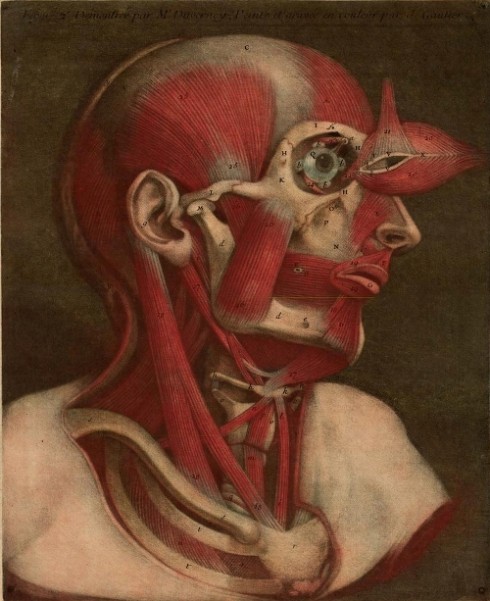
Random thoughts. Margaret Thatcher dies. There are the usual fawning obituaries, but also more than the usual number of attacks, which really speaks to just how widely hated she was, by even those seemingly close to her. At least on a personal level. One gets no sense of her personal appeal, of any intimate attractiveness. She was a repellent sort of lizard-person. Her spawn was feckless inbred and of weak character. Mark Thatcher made news ten years ago when he tried to organize a coup in Equatorial Guinea.
First, Equtorial Guinea is a tiny dot of land on the west coast of Africa. It is a former Spanish colonial holding, and ranks as among the twelve most corrupt and repressive countries in the world. Since the 1970s there have been a dozen attempted coups, all of which have failed. The tiny little dictatorship has vast, disproportionately large oil reserves, and hence, President (sic) Obiang is called a close friend by Condi Rice, and is a known recipient of large cash payments by Exxon, Mobile and Amerada Hess. The U.S. remains friendly and supportive, because, well, there is a lot of oil in that little Republic, and who really cares about the fact that Obiang’s nation ranks first in the world in sex trafficking of children.

The Obamas and the Obiangs, 2009
In 2004, Mark Thatcher, along with a group of British Mercenaries, and probably with help from MI6 and the CIA (its absurd to think the CIA did not at the very very very least sign off on this debacle) decided to overthrow Obiang, and replace him with “opposition” (sic) leader Severo Moto. Now, its the details that are always fascinating in such stories. Moto is a reactionary Catholic with strong fascist sensibilities. He became good friends with proto-reactionary Prime Minister Aznar of Spain, and was granted asylum in that country….only later to be arrested for guns trafficking. http://edition.cnn.com/2008/WORLD/europe/04/15/guinea.arrest/
Anyway, Thatcher’s coup was an exercise in incompetence and ended with mercenary Simon Mann, the boots on the ground leader of the prospective coup, being arrested.
Here from the Guardian UK, is a small portrait of “Scratcher” (I believe Mann was dubbed ‘Smelly’, as fascists always love children’s names…..Netanyahu is ‘Bibi’,etc)…
“Even among the coup plotters, who dubbed him “Scratcher”, he was always a strange figure. “Thatcher was despised as arrogant, pushy and not very bright,” said author Adam Roberts, who interviewed him for his book The Wonga Coup. Aware that he was not fully accepted by the former SAS men and other plotters, Thatcher occasionally introduced himself with the phrase: “Hello, I’m charmless Mark.”
“Not the sharpest pebble on the beach,” one plotter told Roberts. Another contemporary said he had “an ego the size of a herd of elephants and the attention span of a gnat”.
Thatcher matched their scorn by ignoring later pleas for help. A letter written by Mann from prison said Thatcher appeared to ignore calls to help him: “Scratcher asked them to ring back after the grand prix was over! This is not going well.”
This small footnote to the charmless Maggie’s death, is largely ignored in the hagiography of that grotesque harridan, now finally dead. Her son, the talentless, louche simpleton, Sir Mark, 2nd Baronet, caught up in comically disastrous plot to take over a small repulsive former colony, one of the genuine casualties of western interference in Africa.

Mark Thatcher
However, like all the very rich, Scratcher paid no penalty for these failures, but simply retired to his estate in Spain, where he thinks up new motor sport activities (he once took part in the Paris/Dakar rally but along with his driver got lost in the desert for 12 days) and drinks lots of gin.
The reality of life for the poor in places like Equatorial Guinea, bears little resemblance to what one sees in film and TV. I believe Equatorial Guinea has been used as a model for a couple of action/thrillers…..Dogs of War for one, based on the Forsythe novel. I am reminded in another sense of Kowloon, the Walled City — now torn down, but for many decades the most densely populated area on earth.
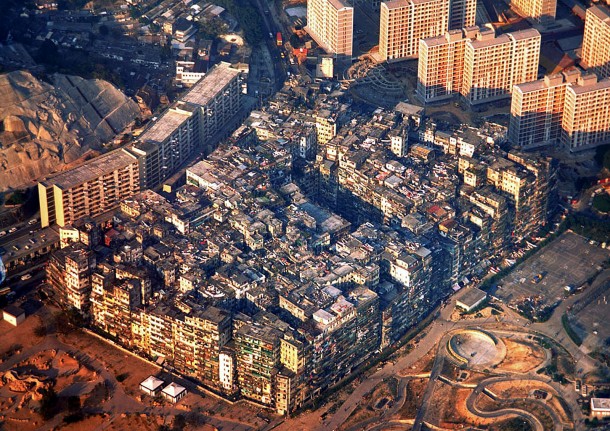
Kowloon, The Walled City
There was one book, City of Darkness, by Greg Girard (also one of my favorite photographers) and Ian Lamboth, that captured life in this extraordinary landscape. What began as a military fort, later became an historical oddity, caught between jurisdictions (British and Chinese) the eventual result was a more or less hands off policy. The city was for many years run by Triads, but later the Hong Kong police enacted massive raids to clean up corruption and crime rates actually lowered. What is fascinating though, is that these statistics in one sense have little meaning. When the Chinese government decided to tear down the city, residents resisted. The anarchic organization, predictably, led to many advantages over the more heavily bureaucratized life of Chinese Hong Kong.

Kowloon, photography Greg Girard
When I lived in Bangkok for a while, there are areas not too dissimilar. They are difficult for westerners to understand, I think. For there is a strange beauty in such architecture, building without plans, spontaneously. The poetics of space, the idea of mystery (and its dangerous to use such words in this case, because there are hidden Orientalist reflexes that will most certainly arise) is implicit, and of autonomy. I am coming to feel this deep need for autonomy in people, in humans, more and more.
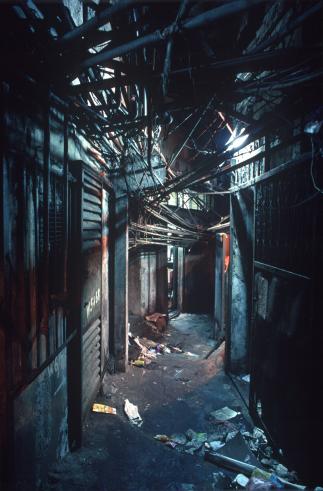
Kowloon, Greg Girard, photography
The sense of instrumental thinking collides with such spaces. There is something almost thrilling about the anarchy, about the reversed notion of organization. There is also the reality that Kowloon was an expression of a bottom up social organizing, and as such, despite the poverty, there were alternative expressions of stability. That this would seem so alien is testimony to just how entrenched notions of authoritarian planning have become.
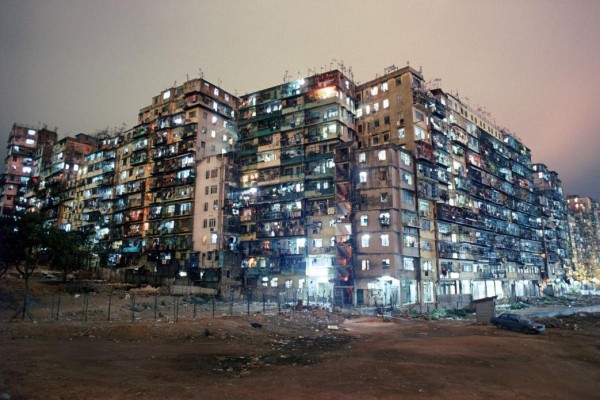
Kowloon, Greg Girard, photography
There are endless associations, aesthetically, emotionally, that skirt through one’s brain. I am reminded that (Benjamin wrote a fragment on this) that Adolph Loos believed (riffing off Goethe) that a work of art must be out of reach (touching copper engravings precludes them from being art) and Benjamin wondered if objects in bottles are thereby works of art. Which for some reason reminded me of notes in bottles cast into the sea. The very idea of which carries so many associations as to freeze the brain.
That sense of mystery is foundational for artworks. The top down authoritarian vision, however, wipes away anything that carries ambiguity or a sense of gradation, or hidden surprise, and insists on resolution both narratively and visually.
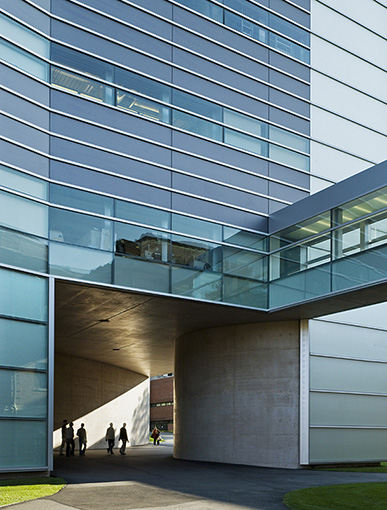
The LISE bldg, Harvard. Photo Anton Grassi
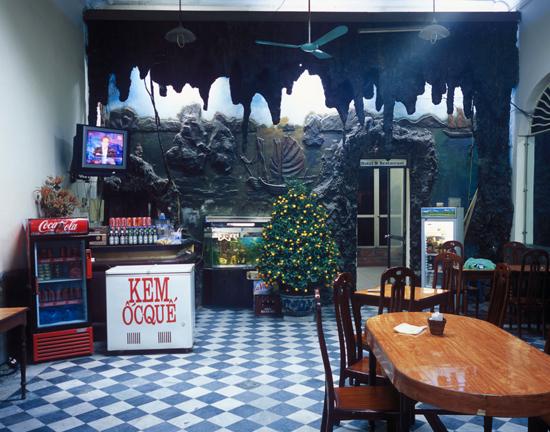
Trocadero Cafe, Hanoi 2010, Greg Girard, photography
The fascist must control, and to control one must “see”; shadow is where plots are formed, where anti social behavior is practiced. So deep are these associations, that I think most westerners rarely think on the visual cues that present themselves — so normative are the themes, ideologically, at work. For ideology is what is out of sight, but not asmystery or the sublime—only propaganda.

Sheldon Adelson, with Eurovegas model
The instrumental logic of domination is expressed in myriad ways. I have written a lot about space. Space as an important article of awareness in artworks. The best work I see now, in film, in theatre, is work in which somehow space is being expressed in non-mediated ways. That’s not easy to describe, but it harnessed to narrative in complex interconnections that often I feel are impossible to dissect. Maybe one shouldn’t even try to dissect them. Perhaps the sense of wanting to explain such things is itself totalitarian.
Global capital, post colonial, has and is changing and altering a sense of space. It does so at the level of lived daily existence, but also, coupled to that, in an aesthetic sense.
Marion Von Osten:
“The tension between the formal and the informal city, between architecture by architects and architecture without architects, has existed since the very beginning of the modern urbanization project. Prompted by capitalist class-making and the influx of rural migration to cities, large housing programs and informal housing increasingly grew up near the city’s borders—the city essentially began to build itself. The trajectories of this tension between the formal and the informal city were major attractors for the emergence of the modernist movement towards the end of the nineteenth century as well. Their studies of vernacular architecture in the Mediterranean and its aesthetics, functions, and structures were partially synthesized into the most modern form of new industrialized building types. Though they were hybrid translations, modernist houses and settlements, with their whitewashed walls, created the idea of a pure form and a hierarchy between the modern and the premodern. By asserting a temporal rupture between the contemporary and the traditional, modernism embraced the possibilities of industrialization and standardized forms. This technocratic and formal approach experienced a deep crisis in the 1950s when the next generation took the self-built environments of hut settlements on colonial ground into account in designing processes and models for urban planning.”
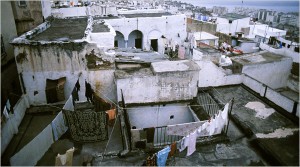
Algiers
Since in theory this blog means to address writing for theatre, and film, I want to then extend some of this thinking to that topic. It seems one of the profound failures of how creative (sic) writing is taught has to do with its ever more narrow definitions, recipes, and influences. Partly this is the tendency for specialization. Students are conditioned to question the idea that a study of architectural space has no relevance for the writing of a play or screenplay.
Von Osten again :
“A result of this shift in perspective was the dispute at the ninth CIAM (Congrès International d’Architecture Moderne) meeting in Aix-en-Provence in the summer of 1953, in which a team of young architects (who later formed the group “Team 10,” when they were charged with organizing the tenth congress) presented new ideas on urbanism and the function of architecture that were highly critical of the functional separation between housing, work, leisure, and transportation in urban planning. In calling for an amendment to the 1933 Athens Charter developed at the first CIAM meeting, the group wanted to call attention to the interconnectedness of housing, street, district, and city, and the meeting ended in conflicts with the congress’ older generation of founding members such as Le Corbusier, Gropius, and Gideon. The context for this dispute were three visual urban studies (so-called “grids”): the “GAMMA Grid” generated by the Service de L’Urbanisme from Casablanca (which included the young George Candilis, Vladimir Bodiansky, and Shadrach Woods), a study of an Algerian shantytown in the “Mahieddine Grid” by Roland Simounet and others; and the “Urban Re-Identification Grid” by Alison and Peter Smithson, a study of how playing children used the street in East London’s working class and colonial migrant district of Bethnal Green. Two of these studies were investigations of the self-built shantytowns that grew up on the outskirts of the French colonial towns of Casablanca and Algiers. All three studies resulted in discussions concerning how the CIAM IX congress itself marked a worldwide shift in approaches to postwar modern building for its presentation of self-built environments as models for understanding the interrelation of public and the private spheres in relation to a new concept called “Habitat.” Discussions stemming from the studies of working class districts and shantytowns led to a generational conflict that marked the dissolution of CIAM as an international organization of the modernist movement”.

What is relevant for writing, and for an understanding of space, is that the post colonial world view entailed a vision of a perfect future consumer paradise. It was the Enlightenment again, and the indelible idea of progress. It was always, in the end, the creation of a commodity. The commodity that helped sell other commodities, often, but the linkage is undeniable. For the writer, looking to find escape from the enclosures of the master discourse, an awareness of why many (most) residents of Kowloon wanted to stay is worth examining. I can already hear the kitsch psychological explanations, but a deeper excavation of this yields both more disturbing, and more idealistic answers.
Benjamin’s interest in that Goethe quote intercedes here as well. The distancing of the real. Our collective societal notions, the accepted truths of progress, are so mediated by paternalistic white supremicism that it utterly clouds what is there of potentially liberating experience.
From Peter Pophams intro to the Girard and Lamboth book City of Darkness (on Kowloon)..
“…what fascinates about the Walled City is that, for all its horrible shortcomings, its builders and residents succeeded in creating what modern architects, with al their resources of money and expertise, have failed to: the city as ‘organic megastructure’, not set rigidly for a lifetime but continually responsive to the changing requirements of its users, fulfilling every need from water supply to religion, yet providing also the warmth and intimacy of a single huge household.”
It is more than this, of course. It is the vital sense of the anti authoritarian impulse at work — and it has an aesthetic element.

Leopold Lambert, who has a great blog, The Funambulist, has written a number of entries on the topic of architecture without architects. He writes….
“The very existence of such architectures provides a strong political stand towards its surrounding. The otherness of the territory allows a different legal and behavioral system to articulate itself.”
In a sense, this is where the political aesthetic arises. The corporate product that now so saturates the reality of the West has, among its many other effects, the normalizing of a totalitarian space, and equally, the criminalizing and pathologizing of any autonomous space.
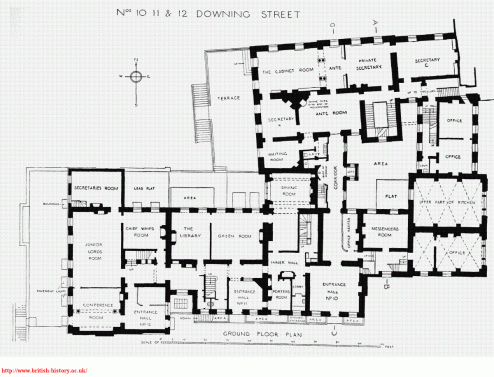
The manner in which this happens is something I intend to write more about, for it links directly to race and gender questions. The imprint of labor, through a lens of misogyny and racism, is evident in almost all Hollywood film these days.
But space is mediated perhaps most of all today, by migration. Space rapidly interfaces with ideas of borders. I wrote about passports and identity, of masculinity, and here of space. This is a planet of new geographic templates built on the interests of transnational corporations, of privatized ventures and financialized capital — the development zones for slave labor and of control and surveillance. The system is built on crises however, this is management totalitarianism. It disseminates a cadance and rhythm of regularity, much like the laugh track on old sit-coms. We are trained to embrace our own crisis, much like its our private reality show. But lurking at the edges of this Oz, just out of reach of this system, of the state, are gardens, and perma culture and community. And these run into migrations. Meanwhile, more drones are launched. More regularity.

Border fence between Mexico and the U.S., outside Nogales
The sense of domination runs through all western image and narrative, now. It is less and less mediated by anything else, for it is increasingly without doubt or self questioning. In the U.S. the current government is deporting more immigrants than ever before. The vast U.S. gulag has more prisoners than ever before. This is a spiritual space, too. The Buddist idea of a hell realm. Solitary confinement is so horrific that even mainstream media is reporting on it.
The practice of writing, the desire to pursue some idea of awakening, of truth, means that these backdrops of Empire, this hierarchical systems of oppression and exploitation need to be questioned and not accepted. But more difficult is the proposition that the writer must discover the aesthetic system, the poetics hidden in plain sight.

So, Thatcher is dead, one of the era’s inventions. The hard pitiless shrunken soul who was the avatar for capitalism — one of the sadistic emotionally challanged leaders of the late 20th century. Her hair a helmeted weaponized coiffe, her mouth a lipless tear in her face. The Thatcher years, like the Reagan years, left a shattered society that was then only fed upon by the scavanger/propriator class. Bush, father and son, Clinton, Blair, and Obama — the self satisfied cultural grave robbers of Empire. The sense of anarchic space, of bottom up reclaiming of territory from the ghouls of this imperialist class, both physical and spiritual, will be savage at times, and certainly impossible to plan, for the planning itself is somehow anethema to the intention. Community organizing, the creation of new spaces, new aesthetic strategies, must reject what is now so hegemonic and enclosing.
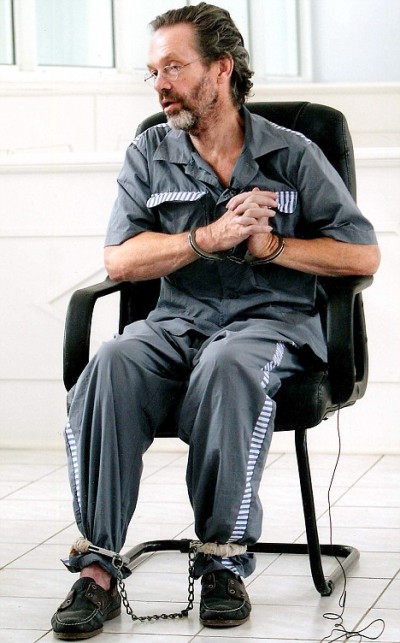
Simon Mann, in custody, Equatorial Guinea
And a last bit of show & tell with the link below…

Your point about autonomy….So important….It’s the only honest place to do work form….The left often wants to believe in a world of standardization, and it’s a fatal error. Always is.
I think, although I agree with you on the regressive polices, that Margaret Thatcher and her son were, it seemed, estranged. And also Thatcher, for whatever reason, stood up to Reagan, as no other PM stood up to a ‘US president’ whilst opposing the fascist junta in Argentina. This is not at all to absolve her of many other policies.
Ah, one last point, the policies of LBJ and others – even much applauded Leftist PM Attlee – led to a centralising of wealth and power in the West, an increased middle class, this middle class was dismantled by various forces, for which Thatcher and Reagan stood as symbols and leaders of- with- in-. The middle class was challenged, and replaced by the ‘new’ middle class: mainly what we would call technocrats in general parlance. So they represented a continuation of policies set off by Leftist and Fascist movements themselves, especially the schizoid masculinist labour movement which often mirrored Reagan – and endorsed him in 1980 lest we forget.
@eilif…..
The collusion of labor with its own demise is an interesting discussion. Part of what was played out in the US was a strange mixing (with all manner of contradiction) of race and class. The ever less empowered white laborer in the US was led to identify with policies not in their self interest…..because they were fed these narratives (black welfare mothers, gangbangers, etc….lazy minorities…etc etc) and then for the far christian right it was also homosexuality — and all these were targeted by the republicans and by reagan. So by the time of Bush, the now even less stable white working class voted overwhelmingly for the man who least represented their self interest. Politics had fully become theatre. Because policy by the time of bush wasnt going to change anymore. Domestically or foreign policy. As for thatcher…..lets not forget her support for and admiration of, General Pinochet. The white elite are the white elite. The queen mum having tea with Ian Smith. etc.
Interesting story and info graphic on Kowloon in South China Morning Post — this month is 20th anniversary of demolition.
http://www.scmp.com/news/hong-kong/article/1191748/kowloon-walled-city-life-city-darkness